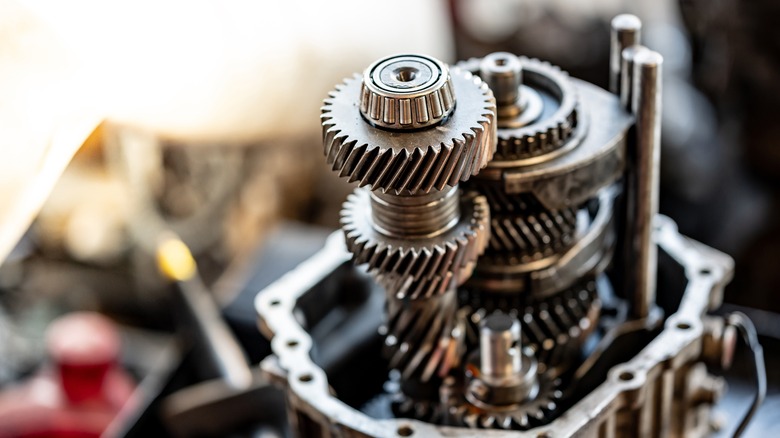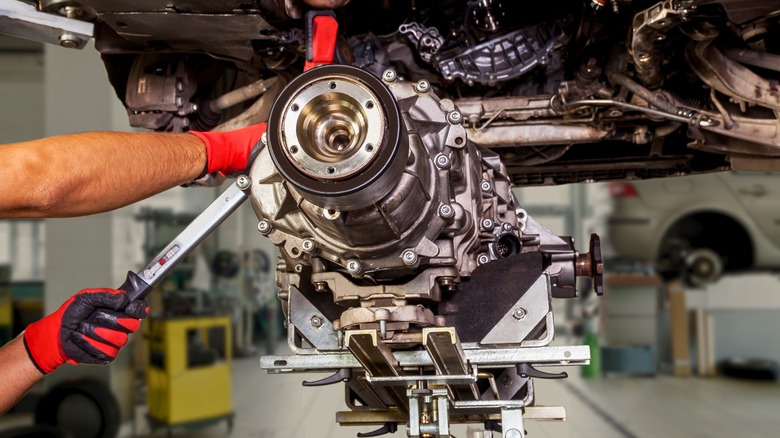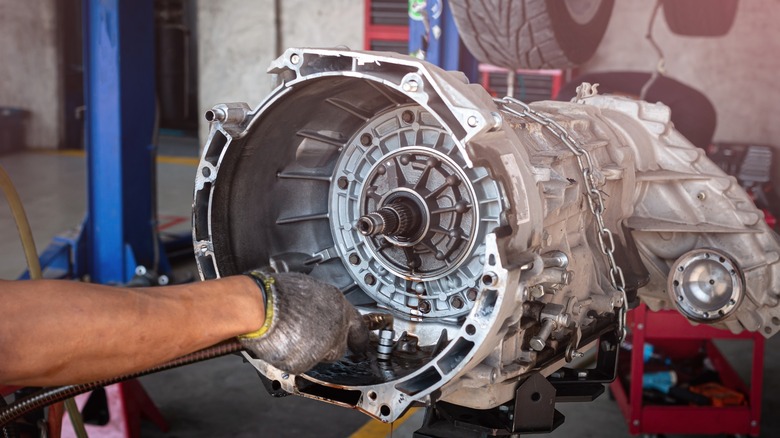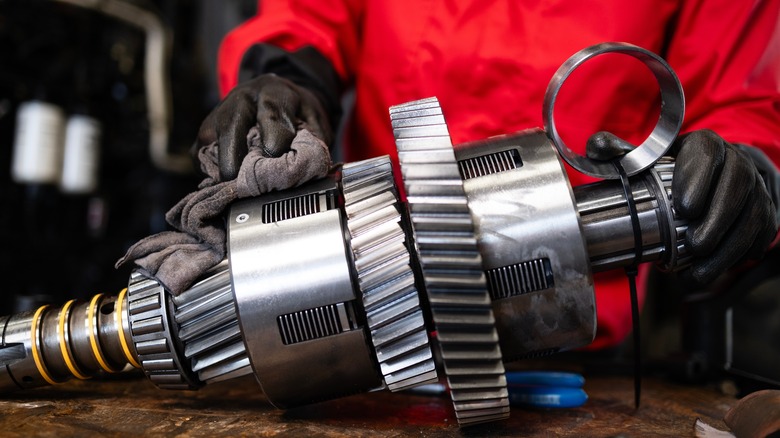The Pros & Cons Of Buying A Used Transmission
Let's suppose the worst-case scenario just occurred, and you find yourself with a car in the shop awaiting a transmission replacement, and you're considering purchasing a used one to swap in. What're some of the advantages or disadvantages of such a purchase over, let's say, rebuilding your current transmission? Or purchasing a brand-new one, better yet? How would you even know that your purchase will be worthwhile and not just a dud in the first place?
For one, used transmissions are generally cheaper, they're available, and they may be high-quality remanufactured parts or like-new. The downsides, however, are that many used transmissions can be hit-or-miss with reliability, it's easy to purchase the wrong one by mistake, parts might be missing, and there's often no warranty.
Before we begin, this article will make some general assumptions about your vehicle. For one, we'll be assuming that your particular make and model has the option for a new transmission; with some particularly eccentric or rare models, you might not have a choice but to buy used. Second, is that the vehicle doesn't have the option to simply continue on its current transmission, it's either totally broken or it's missing from the car (like a project, for instance). Next, we'll assume that it's just the transmission — other components like the clutch or driveshaft are fine. And lastly, we'll discuss both purchasing and installing your own transmission, as well as taking your car to a shop to get it installed.
The upsides of installing a used transmission
Generally speaking, used transmissions come with certain inherent benefits, namely in finances. Particularly with older vehicles using legacy transmissions, such a large and intricate component often commands a hefty sum in material, shipping, and installation. Assuming you have to get it shipped anyway, a used transmission affords a certain amount of wiggle-room because in addition to the difference in price between new and used, you also have the potential to save on shipping costs if it's physically closer. This is because transmissions can weigh well over 100 pounds in many larger cars and trucks, requiring extra shipping costs accounting for weight and dimensions. Plus, rebuilding your current transmission might be even costlier than just purchasing a used one; transmission rebuilds are labor-intensive processes, requiring specialized work to complete.
Another upside is that, assuming you have a vehicle with any amount of aftermarket support, you can generally find a used transmission. Even for legacy or antique models, there's almost always some junkyard or owner of a parts-car with something that'll fit. And with something newer, it's relatively straightforward to find a donor from a totaled car, an auction special, or just someone with some spare parts. Sites like Craigslist, eBay, and others have auto parts categories for this specific reason.
Lastly, let's briefly discuss parts-reliability. A huge turn-off for many buyers is the thought of purchasing something so important from a random stranger online, which is a valid complaint. But there are tools to sort this out, such as customer reviews and ratings systems, accreditations, and contact information. Some of these places operate as reputable shops selling spare parts on the side, a far cry from some person who ripped out their gearbox in their driveway.
The other side of the coin
Of course, not everyone is an accredited shop with good customer reviews, so sometimes you end up purchasing a sketchy unit. What defines something as "not worth it" is if the transmission has a lot of miles already on it (so you won't get much out of it before it needs replacing again), it contains broken or missing parts, or it simply doesn't fit the car or your needs. Some transmissions, for instance, feature different gearing, which is a problem if you tow often, for instance, and buy one with the wrong gear ratios.
Others contain a specific spline count on their output shaft, which is the amount of teeth present on the shaft itself. So if your old output shaft is a 21-spline, let's say, then you might have a problem if you end up with a 23-spline transmission and weren't planning on a far more involved project, often involving driveshaft and/or transfer case swaps. Some even feature identical model codes but different spline counts, like a GM 4L60-E transmission (27 or 30 splines depending on year and part number).
But let's suppose you purchase the correct transmission; the next downside involves there sometimes being no warranty or refund/return policy, which is self-explanatory. This can quickly become a liability if it features a transmission with exceptionally poor reliability; for instance, let's say you're in need of a Nissan CVT. Being notoriously unreliable, the mileage count is far more restrictive than something known to be bulletproof. And with no return policy, you're now left with a lemon stuck on the side of the road in need of a third transmission, at which point it's likely no longer-cost-effective to keep fixing.
Another option: remanufactured transmissions
Lastly, let's take a look at what defines a remanufactured transmission and its unique benefits over a rebuilt or used transmission. Remanufactured transmissions, or "remans" as such components are more broadly called in the vintage automotive community, are used transmissions which are professionally torn-down, deep-cleaned, repaired with brand-new components where needed, and rebuilt from scratch. Such processes are specialized and highly involved, with some companies like Jasper dedicated to remanufacturing components like engines and transmissions. On the plus side, this guarantees quality and, more importantly, quality-assurance. A reman is often as close to a mile-zero transmission as one can get, and will always come with a warranty or other similar guarantee. For many historic cars over 25 years old, this might be your only real option for something properly 100% reliable and correct to the car.
While still technically used, remanufactured transmissions essentially function like-new in both shipping and cost. They usually arrive directly from the remanufacturing company in a sealed box, just like a crate motor, for example. However, they command far higher prices than a standard used transmission because of the processes involved in rebuilding them, as well as other factors like parts-availability. If you're looking for a particularly uncommon transmission, it might need more custom work and therefore the price will go up. That said, customers can get a small rebate since these companies will often buy back your old transmission to use in the remanufacturing process, either for spare parts or as a basis for a new reman.
Depending on your budget, specific needs, knowledge, and parts-availability, a used transmission might be preferable over a reman. But a reman does feature a warranty, and that warranty (and the lack of anxiety that comes with it) will often offset the additional cost.
Getting your transmission rebuilt or replaced with a used example
Lastly, let's discuss rebuilding versus replacement. Unlike remanufacturing, rebuilding is a less specialized process, and many dealership service centers will offer transmission rebuilding or replacement services. This is what often occurs when your car is still under warranty and requires transmission work; it essentially involves taking your current transmission apart and putting it back together again, replacing components as-needed.
However, opt for a used transmission — either because your vehicle no longer has a warranty or any number of other reason — you'll still bring your car to any reliable shop or service center, and they'll perform the required work. Generally, the decision of whether to rebuild your transmission or get it replaced involves weighing the benefits and downsides of each. Is it a more financially-sound decision to perform all that labor-intensive work of rebuilding a transmission from the ground-up, or skipping all of that and simply swapping to a used unit? Depending on factors like weighing the mileage count of both transmissions, labor rates, plus the costs of getting your transmission out in the first place, it might swing one way or the other depending on your car and budget.
That said, while used transmissions should be viewed with healthy skepticism, most are still perfectly viable options for returning your vehicle to working order. Not to mention a far more budget-friendly option, at that.




